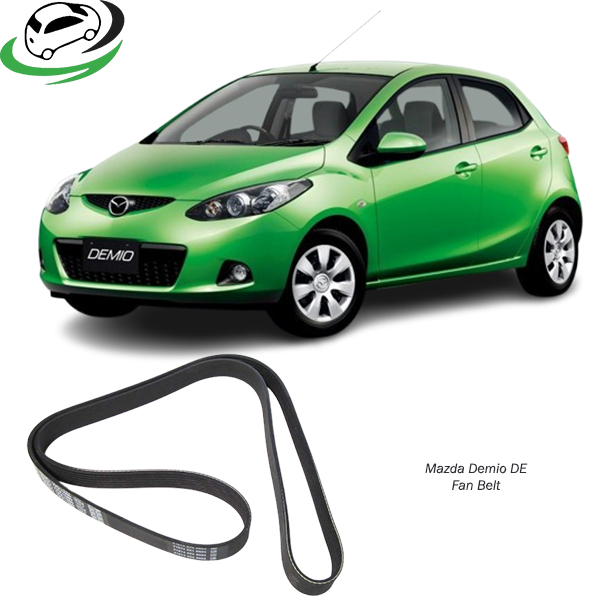-20%
Mazda Demio DE Fan Belt 6pk960 in Kenya
The fan belt, also known as the drive belt or serpentine belt, is an essential component of a vehicle’s engine. It plays a crucial role in driving various accessories in the engine, including the alternator, water pump, power steering pump, and air conditioning compressor. Its operation directly affects the engine’s efficiency, power delivery, and smooth functioning of the vehicle’s accessories. In this detailed guide, we’ll explore the fan belt’s functions, types, benefits, signs of wear, maintenance tips, and common issues.
1. Function of the Fan Belt
The fan belt is a continuous rubber loop that wraps around a series of pulleys connected to various engine components. Its main function is to transfer power from the crankshaft (the rotating shaft at the heart of the engine) to other parts of the engine that need to operate continuously for smooth vehicle function. Here’s how it works with different components:
- Alternator: Powers the alternator, which recharges the battery and keeps the vehicle’s electrical systems operational.
- Water Pump: Helps circulate coolant throughout the engine to prevent overheating.
- Power Steering Pump: Assists in providing easy steering, reducing the effort needed to turn the vehicle.
- Air Conditioning Compressor: Enables the air conditioning system by powering the compressor, ensuring comfortable cabin temperatures.
Each of these systems relies on the fan belt to function effectively, making it a vital component of any vehicle’s operation.
2. Types of Fan Belts
There are different types of fan belts, which vary based on vehicle make, model, and engine design. The two primary types include:
- V-Belt: Typically used in older vehicles, the V-belt has a V-shaped cross-section and fits into pulleys with a corresponding groove. This type of belt provides good grip and minimizes slippage, but a vehicle may require multiple V-belts to power different components.
- Serpentine Belt: Modern vehicles usually have a serpentine belt, which is a single, continuous belt that powers all components. Serpentine belts are flat with grooves on one side, which allow them to move smoothly around various pulleys. They’re more efficient and easier to replace than multiple V-belts.
3. Benefits of a Fan Belt
The fan belt’s importance lies in the key benefits it provides to the engine and vehicle performance, such as:
- Efficient Power Distribution: By connecting the crankshaft to multiple components, the fan belt ensures that these parts receive the necessary power to function properly.
- Reliability and Consistency: High-quality fan belts are designed to operate under constant load and temperature fluctuations, providing reliable service without frequent adjustments.
- Fuel Efficiency: A properly functioning fan belt contributes to fuel efficiency. If it operates optimally, engine components work smoothly, reducing strain on the engine and saving fuel.
- Cost Savings: Regular fan belt maintenance can help avoid costly repairs. By maintaining the belt’s condition, you reduce the risk of sudden failures that might damage related engine components.
4. Signs of a Worn Fan Belt
Over time, fan belts wear out due to continuous exposure to heat, friction, and load. Recognizing the signs of a worn fan belt can help prevent breakdowns and ensure timely replacement. Look for the following indicators:
- Squealing or Chirping Noises: A high-pitched squeal from the engine, especially on startup or acceleration, often signals that the fan belt is slipping. This can happen due to wear, poor tension, or contamination from oil or coolant.
- Visible Cracks or Fraying: Regular inspection may reveal cracks, fraying, or other visible damage to the belt. These indicate weakening and may lead to sudden belt failure.
- Engine Overheating: Since the fan belt powers the water pump, a worn belt may cause inadequate cooling, leading to engine overheating.
- Battery Warning Light: If the belt is slipping or broken, the alternator won’t generate enough power, causing the battery warning light to illuminate on the dashboard.
- Heavy Steering: A worn or slipping belt may fail to power the power steering pump effectively, making it harder to steer the vehicle.
5. Maintenance and Replacement Tips
Proper maintenance is crucial for extending the life of your fan belt and preventing costly repairs. Here are some essential maintenance tips:
- Regular Inspection: Check the fan belt for wear and tension at regular intervals, typically every 10,000 to 15,000 kilometers. Look for any cracks, fraying, glazing, or signs of damage.
- Check Tension: Fan belts must have the right tension to function properly. Over time, they may stretch, so it’s important to ensure the belt maintains the correct tension. Some vehicles have automatic tensioners, while others may require manual adjustment.
- Keep the Belt Clean: Contaminants like oil, coolant, and debris can damage the belt. Make sure the belt and the area around it remain clean. If the belt becomes contaminated, clean it with a suitable belt cleaner.
- Replace When Necessary: A typical fan belt lasts between 50,000 and 100,000 kilometers, depending on driving conditions and maintenance. Follow your vehicle’s manual for recommended replacement intervals, but also replace the belt if it shows signs of wear.
6. Common Issues and Solutions
Fan belts can encounter issues over time, particularly when maintenance is neglected or when operating under harsh conditions. Some common issues include:
- Belt Slippage: This is usually due to incorrect tension or contamination. It may cause a squealing noise and reduce the efficiency of connected components. Adjusting the tension or replacing the belt can resolve this issue.
- Misalignment: If the pulleys are misaligned, the belt may wear unevenly, leading to premature failure. Have a mechanic check pulley alignment and make adjustments if necessary.
- Pulley Damage: Damaged or worn pulleys can cause additional friction, reducing the lifespan of the belt. Pulley replacement is sometimes required to prevent recurrent belt wear.
- Heat and Age-Related Wear: Continuous exposure to engine heat causes the belt’s rubber material to degrade over time. This can result in cracks, glazing, and brittleness. Replacing the belt with a high-quality option designed to withstand heat can help extend its lifespan.
7. Fan Belt Replacement Process
Replacing a fan belt is a straightforward process, but it requires the right tools and careful attention. Here’s a general outline:
- Locate the Belt: Open the hood, locate the belt, and identify the routing pattern. Many vehicles have a diagram under the hood showing how the belt loops around each pulley.
- Release Tension: Use a wrench or socket to release tension from the belt. For vehicles with automatic tensioners, use a suitable tool to rotate the tensioner and relieve tension.
- Remove the Old Belt: Slip the old belt off the pulleys carefully, taking note of the routing.
- Install the New Belt: Loop the new belt over the pulleys according to the routing pattern, ensuring it sits properly in each groove.
- Restore Tension: Release the tensioner to tighten the belt, then double-check to ensure it’s properly seated on all pulleys.
- Inspect and Test: Start the engine and inspect the belt’s operation, listening for any unusual sounds that might indicate misalignment.
8. Cost and Quality Considerations
When replacing a fan belt, choose one from a reputable manufacturer to ensure durability and reliability. Costs vary based on the belt type, quality, and labor if you hire a professional. High-quality belts may cost more but provide better performance and last longer, making them a worthwhile investment.
Conclusion
The fan belt is a crucial component of vehicle operation, impacting everything from engine cooling to power steering and charging the battery. Regular inspection, maintenance, and timely replacement are essential for optimal performance and safety. By keeping your fan belt in good condition, you’re not only preventing costly repairs but also ensuring a smoother, safer drive every time.
Follow us on Facebook for more parts.



